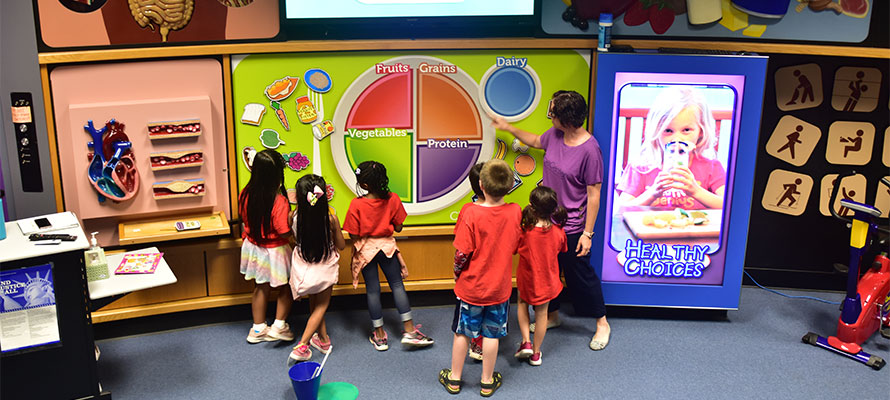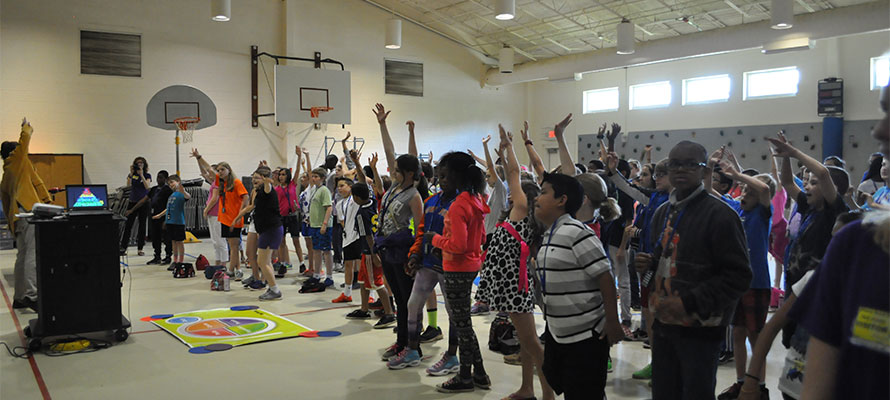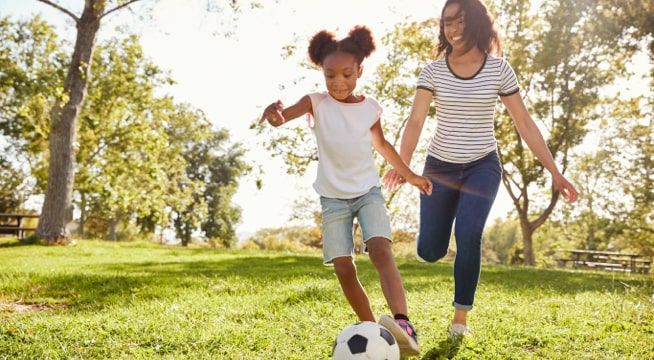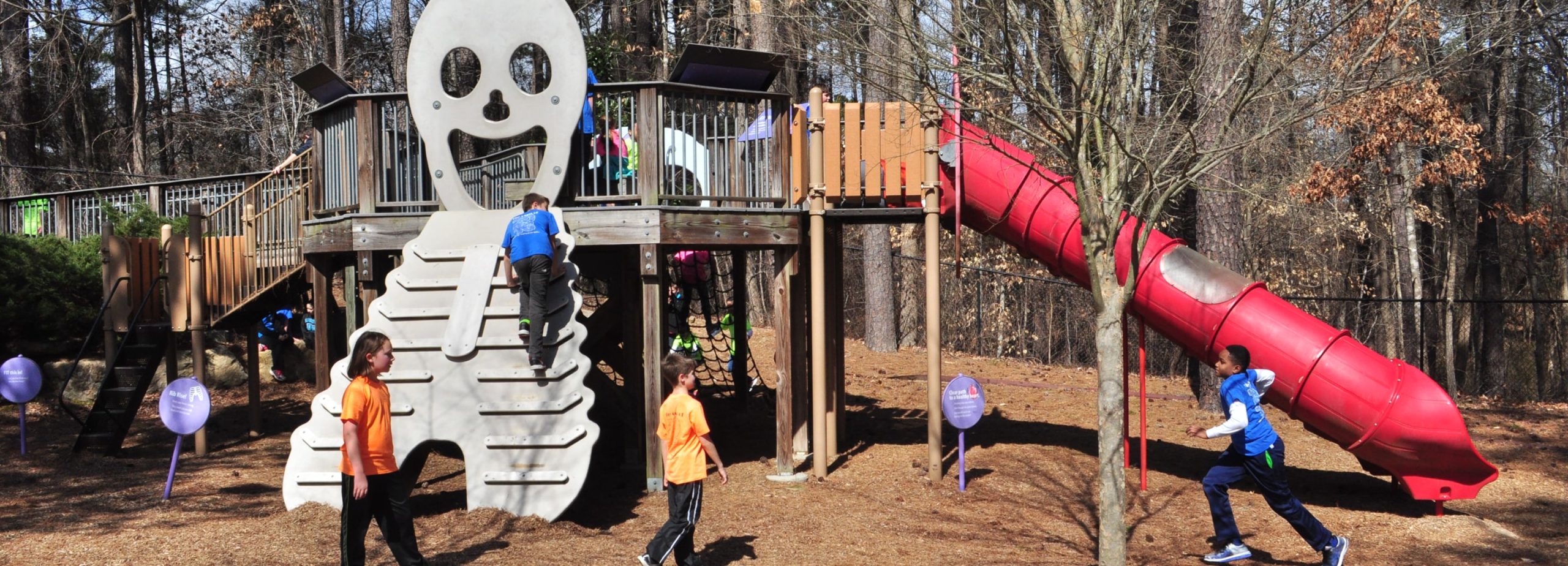Nutrition and Physical Activity
Making healthy food choices and being active are at the heart of the Poe Center’s Nutrition & Physical Activity programs.
Program participants learn about eating from five food groups, simple ways to make healthy food choices, and ways to get 60 minutes of physical activity each day.
The Poe Center’s one-of-a-kind nutrition-themed teaching theater features a gigantic magnet food plate and interactive nutrition facts label. Engaging activities make learning fun and memorable.
Programs may be presented at the Poe Center or our staff can bring them to your location in person or online.
Religious protections for USDA program beneficiaries | Nondiscrimination Statement / Aviso de No Discriminación






-
Grow It, Try It, Like It
Schedule this program for: Preschool,
Pre-schoolers will enjoy physical activity, literacy, songs, nutrition education activities and a fruit or vegetable tasting in this seven-session series. The 30-minute sessions are built on the MyPlate model and introduce participants to three fruits - peaches, strawberries, and cantaloupe, and three vegetables - spinach, sweet potatoes, and crookneck squash. This garden-themed nutrition education program can be done as a series of sessions or as an individual session. Take home materials promote learning at home with fun parent/participant activities and family-sized recipes that give tips for cooking with participants. Can be scheduled for 1, 2, 3, 4, 5, 6, or 7 sessions. Program Length: 30 minutes/ session
-
Fitness Is Fun (Virtual Only)
Schedule this program for: Kindergarten, 1st Grade, 2nd Grade,
"Fitness is Fun" introduces participants to various ways to be physically active. Learn about the activity pyramid, the importance of physical activity, and plan easy and nutritious lunches and snacks. Please note: This program is only offered online via video conferencing.
Program Length: 45 minutesMeets NC DPI Healthful Living Essential Standards:-
- Kindergarten:
- K.NPA.1 Identify sources of food and water and their importance to the body.
- K.NPA.1.1 Recognize that food gives us energy.
- K.NPA.1.2 Identify that fruits and vegetables come from plants.
- K.NPA.2 State the importance of physical activity for the body.
- K.NPA.2.1 List ways to be physically active.
- PE.K.HF.3 Demonstrate the knowledge and skills needed to achieve a health-enhancing level of physical activity and fitness.
- PE.K.HF.3.2 Identify opportunities for increased physical activity.
- 1st Grade:
- 1.NPA.1 Describe where food and water come from and their importance to the body.
- 1.NPA.1.2 Explore a variety of foods and why it’s important to eat them
- 1.NPA.1.3 Categorize the sources of a variety of foods.
- 1.NPA.2 Recognize the benefits of physical activity for the body.
- 1.NPA.2.1 List physical activities that are beneficial to your body.
- 1 NPA.2.2 Describe enjoyable physical activities that can be done inside and outside of school.
- PE.1.HF.3.2 Identify benefits of being physically active.
- 2nd Grade:
- 2.NPA.1 Explain where food and water come from and their importance to the body.
- 2.NPA.1.1 Explain the importance of eating a variety of foods from different groups according to the USDA.
- 2.NPA.1.2 Classify foods into groups according to USDA.
- PE.2.HF.3.2 Identify ways to be physically active outside of physical education class.
- Kindergarten:
-
-
Healthy Harvest Festival
Schedule this program for: Kindergarten,
This active and engaging program, specifically designed for kindergarten, highlights the five food groups using MyPlate. Participants will learn where and how foods grow, encouraging the consumption of non-processed foods. A healthy lifestyle is modeled through discussion of daily exercise, adequate sleep, hydration, and proper handwashing. The program demonstrates the value of community by appreciating cultural differences as participants help prepare for their own Healthy Harvest Festival.
Program Length: 30 minutesMeets NC DPI Healthful Living Essential Standards:-
- Kindergarten
- K.NPA.1 Understand MyPlate as a tool for selecting nutritious foods.
- K.NPA.1.1 Classify foods by groups in MyPlate.
- K.NPA.1.2 Recall foods and beverages beneficial to teeth and bones.
- K.NPA.2 Understand the importance of consuming a variety of nutrient dense foods and beverages in moderation.
- K.NPA.2.1 Recognize nutrient-dense foods in a list of foods that are culturally diverse.
- K.NPA.2.2 Summarize the importance of a healthy breakfast and lunch.
- K.NPA.1.3 Recall activities for fitness and recreation during out of school hours.
- K.PCH.1.1 Use steps of correct hand washing at appropriate times throughout the day.
- Kindergarten
-
-
PoeMANIA!
Schedule this program for: Kindergarten, 1st Grade, 2nd Grade, 3rd Grade, 4th Grade, 5th Grade, Adult & Child,
Are you ready to “come on down” and participate in a fun-filled game show? Join our hosts for a nutrition and physical activity-themed, interactive, and educational program. This program is designed for all ages. Groups of up to 200 can participate, and FAMILIES can compete TOGETHER to reach the “Million Dollar” question. Please note: This assembly-style program is designed for large groups consisting of both youth and adults.
Ages: 5 and Up Program Length: 1 hour -
Healthy Habits
Schedule this program for: 1st Grade,
Participants explore the importance of developing healthy habits, discuss food groups on the USDA’s MyPlate, and visit the “Poe Cafeteria” to practice building a balanced plate. The program promotes making half your plate fruits and vegetables, getting 60 minutes of physical activity daily, and having a healthy heart.
Program Length: 45 minutesMeets NC DPI Healthful Living Essential Standards:-
- First Grade:
- 1.NPA.1: Describe where food and water come from and their importance to the body.
- 1.NPA.1.1: Name the reasons why we need to drink water.
- 1.NPA.1.2: Explore a variety of foods and why it’s important to eat them.
- 1.NPA.1.3: Categorize the sources of a variety of foods.
- 1.NPA.2: Recognize the benefits of physical activity for the body.
- 1.NPA.2.1: List physical activities that are beneficial to your body.
- 1.NPA.2.2: Describe enjoyable physical activities that can be done inside and outside of school.
- First Grade:
-
-
Power Up with Play
Schedule this program for: 2nd Grade,
Power Up with Play promotes the benefits of eating from the various MyPlate food groups and getting daily physical activity. Participants learn to recognize their body's signals indicating they are feeling hungry or thirsty, all while discovering fun physical activities that may be enjoyed every day.
Program Length: 45 minutesMeets NC DPI Healthful Living Essential Standards:-
- Second Grade
- 2.NPA.1 Explain where food and water come from and their importance to the body.
- 2.NPA.1.1 Explain the importance of eating a variety of foods from different groups according to the USDA.
- 2.NPA.1.2 Classify foods into groups according to the USDA.
- 2.NPA.1.3 Describe the body’s signals when you are hungry and thirsty.
- 2.NPA.1.4 Compare and contrast possible benefits of eating a meal with family or friends versus eating alone.
- 2.NPA.2 Examine the benefits of physical activity.
- 2.NPA.2.1 Explain why the body needs physical activity.
- Second Grade
-
-
Menus, Muscles and More (Virtual Only)
Schedule this program for: 3rd Grade, 4th Grade, 5th Grade,
“Menus, Muscles and More” increases participants’ knowledge of a healthy lifestyle, the benefits of healthy behaviors, and the components of physical activity. Participants will also learn more about the heart and its importance in physical activity. Please note: This program is only offered online via video conferencing.
Program Length: 45 minutesMeets NC DPI Healthful Living Essential Standards:-
- Third Grade:
- 3.NPA.1 Recall why the body needs a variety of foods.
- 3.NPA.1.1 Recall the food groups and what foods are in each food group, according to the USDA.
- 3.NPA.1.2 Identify food group components of a variety of example meals
- 3.NPA.2 Investigate factors that influence which foods we eat.
- 3.NPA.2.1 List the factors that influence which foods you eat.
- 3.NPA.2.2 List the body’s signals when you are hungry and thirsty.
- 3.NPA.3 Examine the benefits of physical activity
- 3.NPA.3.1 Categorize different activities for all levels of ability in order to promote overall wellness.
- Fourth Grade:
- 4.NPA.1 Interpret tools to apply nutrition information.
- 4.NPA.1.2 Explain that foods are generally grouped into food groups based on the nutrients they provide
- 4.NPA.3 Compare the benefits of different activities for your body to promote wellness.
- 4.NPA.3.2 Describe the benefits of drinking water before, during, and after physical activity.
- Fifth Grade:
- 5.NPA.1 Use tools and resources to interpret nutrition information
- 5.NPA.1.2 Using the USDA Food Groups plan a meal with 3-5 food groups included.
- 5.NPA.2 Understand the importance of consuming a variety of nutrient dense foods and beverages in moderation.
- 5.NPA.2.2: Infer the benefits of limiting the consumption of foods and beverages high in fat and added sugar.
- 5.NPA.3 Evaluate the benefits of different activities for your body to promote wellness
- 5.NPA.3.1: Develop a plan to implement a variety of physical activities into your daily routine that includes warm-up, stretching, and proper hydration.
- Third Grade:
-
-
Play Hard, Stay Fit
Schedule this program for: 3rd Grade,
Play Hard, Stay Fit examines the questions of “What is exercise?” and “What does it mean to be healthy?” Using the Activity Pyramid, participants examine personal fitness goals, the benefits of a healthy lifestyle, and how physical activity benefits every aspect of their lives.
Program Length: 45 minutesMeets NC DPI Healthful Living Essential Standards:-
- Third Grade
- 3.NPA.1: Recall why the body needs a variety of foods.
- 3.3.NPA.1.1: Recall the food groups and what foods are in each food group, according to the USDA.
- 3.NPA.1.2: Identify food group components of a variety of example meals.
- 3.NPA.1.3: Plan activities for fitness and recreation during out of school hours.
- 3.NPA.2: Investigate factors that influence which foods we eat.
- 3.NPA.2.1: List the factors that influence which foods you eat.
- 3.NPA.2.2: List the body's signals when you are hungry and thirsty.
- 3.NPA.3: Examine the benefits of physical activity.
- 3.NPA.3.1: Categorize different activities for all levels of ability in order to promote overall wellness.
- PE.3.HF.3: Demonstrate the knowledge and skills needed to achieve a health-enhancing level of physical activity and fitness.
- PE.3.HF.3.1: Identify four or more of the five health-related fitness components (cardiorespiratory endurance, muscular strength, muscular endurance, flexibility, and body composition) and their associated exercises.
- PE.3.HF.3.2: Demonstrate understanding of physical activity as a way to become healthier.
- PE.3.HF.3.3: Develop personal goals to improve one or more of the health-related fitness components
- Third Grade
-
-
Nutrient Superheroes
Schedule this program for: 4th Grade,
The Nutrient Superheroes program is an exciting and fun adventure that promotes good health through the power of food! Participants learn about each nutrient’s superpowers and what they do for their bodies. Identifying which nutrients are prominent in each food group, understanding basic food labels, and building healthy meals and snacks are presented through engaging activities.
Program Length: 60 minutes-
- Fourth Grade
- 4.NPA.1: Interpret tools to apply nutrition information
- 4.NPA.1.1: Using a school lunch or breakfast menu, plan a meal that includes 3-5 different food groups.
- 4.NPA.1.2: Explain that foods are generally grouped into food groups based on the nutrients they provide.
- 4.NPA.2: Explore external factors that affect the food you eat.
- 4.NPA.2.2: List measures to prevent food borne illnesses, including washing hands and food storage methods.
- 4.NPA.3: Compare the benefits of different activities for your body to promote wellness.
- 4.NPA.3.1: Identify short- and long-term benefits of moderate and vigorous physical activity.
- 4.NPA.3.2: Describe the benefits of drinking water before, during, and after physical activity.
- 4.HF.3 Demonstrate the knowledge and skills needed to achieve a health-enhancing level of physical activity and fitness.
- PE.4.HF.3.1: Identify each of the five health-related fitness components (cardiorespiratory endurance, muscular strength, muscular endurance, flexibility, and body composition) and their associated exercises.
- Fourth Grade
-
-
Food for Thought
Schedule this program for: 5th Grade,
Why do you need food? What influences food choices? How much daily movement do you need? Can you exercise at home? “Food for Thought” is an interactive program that invites participants to critically think about healthy habits. This program guides discussions about food choices, essential nutrients, and physical activity. Group activities include building a meal with MyPlate food groups and a 5-step plan for daily movement.
Program Length: 60 minutesMeets NC DPI Healthful Living Essential Standards:-
- Fifth Grade
- 5.PCH.1.2: Outline personal strategies to obtain sufficient sleep and regular physical activity.
- 5.PCH.3: Understand body systems and organs, functions, and their care.
- 5.PCH.3.1: Summarize the functions of the organs which make up the digestive system.
- 5.NPA.1.1: Name the primary nutrients that each food group provides.
- 5.NPA.1.2: Using the USDA Food Groups plan a meal with 3-5 food groups included.
- 5.NPA.2: Investigate external factors that affect which foods we eat.
- 5.NPA.2.1: Describe how family and culture influence food choices, other eating practices, and enjoyment of food.
- 5.NPA.2.2:Describe how school and community settings influence food choices and other eating practices and behaviors.
- 5.NPA.2.3:Describe how media/technology influence what and how we eat.
- 5.NPA.3.1:Develop a plan to implement a variety of physical activities into your daily routine that includes warm-up, stretching, and proper hydration.
- Fifth Grade
-
-
Elevate Your Energy (Virtual Only)
Schedule this program for: 6th Grade, 7th Grade, 8th Grade, 9th Grade, 10th Grade, 11th Grade, 12th Grade,
Take good nutrition and physical activity to the next level. Participants examine healthy eating patterns that strengthen nutrition and analyze food labels to make informed food choices. This program emphasizes the importance of daily movement and demonstrates different methods of being active. Participants also identify media and peer pressures that may negatively influence attitudes towards health behaviors. Please note: This program is only offered online via video conferencing.
Program Length: 45-60 minutes -
Mission Nutrition
Schedule this program for: 6th Grade, 7th Grade,
Mission Nutrition is an interactive and conversational program that navigates the challenges of balancing food and physical activity. Participants engage in a quest to discover the importance of food labels, ingredient lists, essential nutrients, and meal times. Participants gain a better understanding of daily movement with tools such as the FITT principle and 5 components of fitness. Will YOU answer the call for Mission Nutrition?
Program Length: 60 minutes-
- Sixth Grade
- 6.NPA.1: Compare tools such as Dietary Guidelines and the Nutrition Facts Label as they relate to the planning of healthy nutrition and physical activity.
- 6.NPA.1.1: Attribute the prevention of nutrition related diseases to following the Dietary Guidelines for Americans.
- 6.NPA.1.2: Evaluate food choices using Nutrition Facts labels.
- 6.NPA.2: Explore the benefits of consuming a variety of foods and beverages.
- 6.NPA.2.1: Identify the six essential nutrients to make informed decisions regarding healthy eating.
- 6.NPA.3: Apply lifelong nutrition and health-related fitness concepts to enhance quality of life.
- 6.NPA.3.1: Explain the relationships between food consumption, physical activity, and overall health.
- Seventh Grade
- 7.NPA.1: Apply resources to plan and employ balanced nutrition and physical activity plans.
- 7.NPA.2: Apply healthy nutrition and physical activity concepts to enhance quality of life.
- 7.NPA.2.2: Implement a personal health plan that balances nutrition and physical activity.
- Sixth Grade
-
-
Media Mythbusters
Schedule this program for: 8th Grade,
Participants become Media Mythbusters while debunking 5 common myths portrayed in the mass media regarding health, nutrition, and physical activity. In this nutrition program that highlights how the media influences choices, participants learn how to identify fad diets, decode packaging claims, create a well rounded exercise routine, examine the importance of having a positive self image, and apply these skills to create their own health messaging.
Program Length: 60 minutes Program type: Virtual-
- Eighth Grade
- 8.MEH.1 Evaluate how structured thinking benefits emotional well-being.
- 8.MEH.1.2 Explain how personal responsibility for one’s choices is linked to self-worth and growth.
- 8.PCH.1 Understand wellness, disease prevention, and recognition of symptoms.
- 8.PCH.1.2 Explain behavioral and environmental factors that contribute to major chronic diseases and the methods for reducing problems associated with common conditions.
- 8.PCH.2 Apply health literacy skills when examining health claims and products.
- 8.PCH.2.1 Create a PSA about a health topic using evidence-based information.
- 8.PCH.2.2 Demonstrate how to influence and support others to make positive health choices.
- 8.NPA.1 Demonstrate healthy practices and behaviors that will maintain or improve the health of self and others.
- 8.NPA.1.1 Examine the destructive nature of body shaming and negative body image.
- 8.NPA.1.2 Explain the importance of assuming responsibility for personal dietary choices.
- 8.NPA.1.3 Identify resources to advocate for those who are at risk for poor nutrition.
- 8.NPA.2 Apply strategies to consume a variety of foods and beverages.
- 8.NPA.2.1 Summarize the benefits of consuming adequate amounts of micronutrients and water in a variety of foods.
- 8.NPA.3 Explore various diet and physical activity trends to enhance quality of life.
- 8.NPA.3.1 Identify risks and benefits of various dietary preferences and eating patterns.
- 8.NPA.3.2 Summarize the benefits and risks of current physical activity trends.
- 6-8.HF.3 Demonstrate knowledge and skills needed to achieve a health enhancing level of physical activity and fitness.
- PE.6-8.HF.3.1 Describe the FITT principle and training principles (frequency, intensity, time, type, overload, progression, specificity), and how they affect physical fitness for each of the five health-related fitness components.
- PE.6-8.HF.3.2 Summarize the potential short- and long-term physical, social, and emotional benefits of physical activity.
- PE.6-8.HF.3.4 Participate in a variety of moderate to vigorous activities with the goal of accumulating at least 60 minutes of physical activity per day, either during or outside of school, at least 5 days per week.
- 6-8.PR.4 Demonstrate responsible personal and social behavior that respects self and others.
- PE.6-8.PR.4.1 Demonstrate self-management, responsible decision making, and problem-solving skills in a physical activity setting.
- 8.MEH.1 Evaluate how structured thinking benefits emotional well-being.
- Eighth Grade
-
-
Nourish & Thrive
Schedule this program for: 9th Grade, 10th Grade, 11th Grade, 12th Grade, Adults,
Have you ever wondered about the connection between your physical health and mental wellness? Nourish & Thrive uncovers the mystery of nutrition, physical activity, the gut biome, and mental wellness. This program promotes brain development with activities focused on healthy habits, self-care tips, neurotransmitter function, and nutrition. Nutrition topics include USDA MyPlate food groups, hydration, and foods to prioritize a healthy gut. Program Length: 60-90 minutes Meets NC DPI Healthful Living Essential Standards:
-
- 9.MEH.1.1 Identify causes, symptoms, and strategies for treating mental health challenges.
- 9.MEH.2.2 Explore healthy strategies for managing stress, anxiety, anger, and impulsive behaviors.
- 9.ANCOD.2.2 Evaluate positive and negative influences on health practices and behaviors.
- 9.PCH.1.7 Assess personal health practices and overall health status.
- 9.NPA.1.2 Summarize the benefits of consuming the six essential nutrients in adequate amounts in a variety of foods.
- 9.NPA.2.2 Summarize the effects of hydration and dehydration and preventative measures for dehydration.
- 9.NPA.3 Analyze health behaviors in relation to community and global disease prevention.
- 9.NPA.4 Apply lifelong nutrition and physical activity concepts to enhance quality of life.
-
-
Wellness Works
Schedule this program for: 9th Grade, 10th Grade, 11th Grade, 12th Grade, Adults,
Get ready to level up your health with Wellness Works - an interactive nutrition and wellness program designed to help participants take charge of their health! Through engaging activities, games, and real-world challenges, participants explore how food, exercise, sleep, and stress impact the body and mind. Using USDA guidelines, participants will decipher nutrition labels, create balanced meals, and build habits that boost energy, focus, and overall well-being - because small choices today lead to a stronger, healthier future.
Program Length: 60 minutesMeets NC DPI Healthful Living Essential Standards:-
- 9.NPA.1: Describe the prevalence, causes and long-term consequences of poor nutrition, extended screen time, and sedentary lifestyle.
- 9.NPA.1.1: Summarize evidence-based approaches for individual prevention of disease.
- 9.NPA.1.2: Summarize evidence-based approaches for community prevention of disease.
- 9.NPA.2: Develop strategies to consume a variety of foods and beverages.
- 9.NPA.2.1: Summarize the benefits of consuming the six essential nutrients in adequate amounts in a variety of foods.
- 9.NPA.2.2: Summarize the effects of hydration and dehydration and preventive measures for dehydration.
- 9.NPA.3: Analyze health behaviors in relation to community and global disease prevention.
- 9.NPA.3.1: Evaluate how the school and community culture can affect personal health practice and behaviors.
- 9.NPA.3.2: Advocate for those experiencing local and global barriers that interfere with optimal health.
- 9.NPA.4: Apply lifelong nutrition and physical activity concepts to enhance quality of life.
- 9.NPA.4.1: Design and implement a personal physical activity program with safety and effectiveness.
- 9.NPA.4.2: Identify appropriate methods to avoid/respond to the climate-related conditions during physical activity that impact overall health.
- 9.NPA.4.3: Evaluate your personal fitness plan.
- 9.NPA.1: Describe the prevalence, causes and long-term consequences of poor nutrition, extended screen time, and sedentary lifestyle.
-
-
Strong and Balanced
Schedule this program for: 11th Grade, 12th Grade, Adults,
Focusing on goal setting and habit building, Strong & Balanced provides real-life tools for building healthy snacks and meals, shopping for healthy foods, increasing water intake, improving sleep, and managing stress. Participants are empowered to be more mindful about their health through meditation, mobility exercises, and affirmations.
Program Length: 30 - 45 minutes, in-person only-
- 9.NPA.2 Develop strategies to consume a variety of foods and beverages.
- 9.NPA.2.1 Summarize the benefits of consuming the six essential nutrients in adequate amounts in a variety of foods.
- 9.NPA.2.2 Summarize the effects of hydration and dehydration and preventive measures for dehydration.
- 9.NPA.4 Apply lifelong nutrition and physical activity concepts to enhance quality of life.
- 9.NPA.4.1 Design and implement a personal physical activity program with safety and effectiveness.
- 9.NPA.4.3 Evaluate your personal fitness plan.
- 9.HF.3 Demonstrate the knowledge and skills needed to achieve a health-enhancing level of physical activity and fitness.
- 9.PCH.1 Understand wellness, disease prevention, and recognition of symptoms.
- 9.PCH.1.5 Identify measures to improve sleep and rest habits.
- 9.PCH.1.7 Assess personal health practices and overall health status.
- PE.9.HF.3.2 Analyze factors that affect personal health and physical activity behaviors to determine appropriate goals and strategies to improve health-related outcomes.
- PE.9.HF.3.4 Participate in targeted activities based on interests, accessibility, and personal goals to improve health-related fitness.
- 9.MEH.2 Identify a variety of positive stress management and self-regulation strategies that would benefit overall health.
-
-
Eat Smart, Live Strong
Schedule this program for: Senior Adults (60+),
If happier and healthier is on your menu, then Eat Smart, Live Strong is made to order for you. This four-session program is especially designed for seniors and older adults. Each session will provide adults with the skills they need to increase dietary fruits and vegetables and strategies to get in 30 minutes of physical activity on most days. The sessions include simple body movements that are easy to incorporate and interactive nutrition discussions that will whet your appetite for more.
Program Length: Four 60-minute sessions -
Stay Strong, Stay Healthy
Schedule this program for: Senior Adults (60+),
Stay active, stay independent with strength training. “Stay Strong, Stay Healthy” is an evidence-based program designed to help older adults build strength, improve balance, and stay active for life. With support from trained instructors, participants use simple chair and standing exercises that can be tailored to their abilities.
Program Length: Two exercise sessions (45-60 minutes) per week for 8 weeks. Plus:- One pre-assessment session (60-90 minutes)
- One post-assessment session (45-60 minutes)


